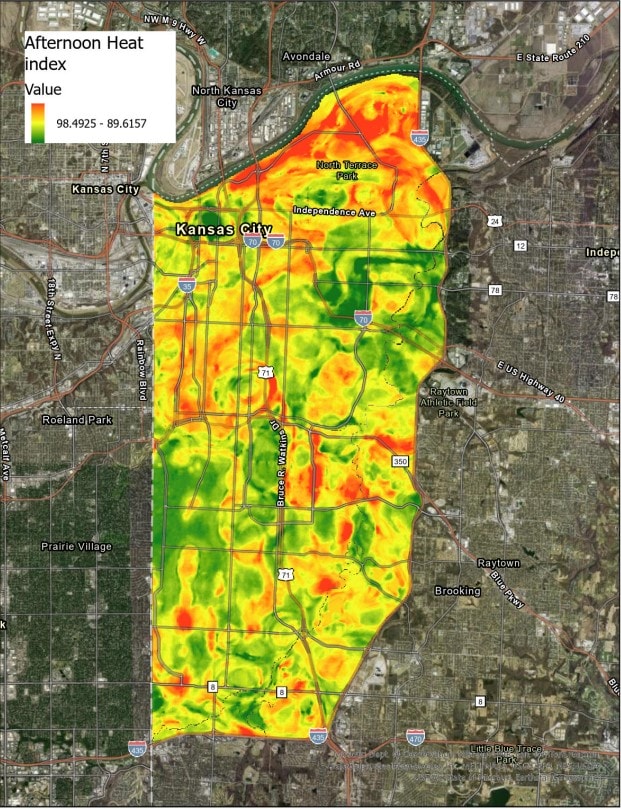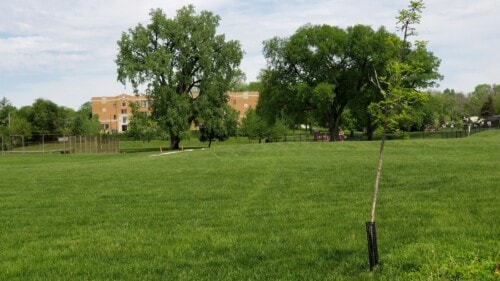Push to Plant Trees in Kansas City Takes Root Influx of Federal Funding Helps Fight Heat Islands, Climate Change
Published March 5th, 2024 at 6:00 AM
Above image credit: Sunrise in downtown Kansas City. (Jonathan Tasler | CAPA Strategies' Kansas City Heat Watch Report)Trees are being planted across Kansas City at an unprecedented pace, putting the city in the front ranks of American cities aggressively fighting climate change.
An ongoing campaign to maintain Kansas City’s existing tree canopy is being broadened. Meanwhile, efforts to enhance native grasses and wildflowers across the metropolitan area are taking on new life and urgency.
Tree preservation will kick into high gear in June when a $12 million windfall grant from the U.S. Department of Agriculture reaches city coffers. The influx will enable the city to provide greater care to our existing arboreal canopy, which includes many aging trees planted after World War II.
That federal infusion is in addition to money the city budgeted this fiscal year and next for its 10,000 Tree Campaign focused on heat islands in the older, poorer sections of the city, and for giving residents trees to plant in their yards.
City Manager Brian Platt said 3,000 trees were planted in Kansas City this city fiscal year, which ends April 30. That number will jump to 4,000 trees in the upcoming year.
“We haven’t been planting trees at this pace ever,” Platt said.
“Three thousand to four thousand trees a year is on pace with any city in the country,” he said. “We want to be a leader in sustainability. We are going to be a national leader.”
Five-Year Program
All told, the city allocates $3.5 million for trees.
“The $12 million will be on top of the $3.5 million,” Platt said in an interview with Flatland.
Sherae Honeycutt, the city manager’s press secretary, elaborated.
“This is a five-year program, and the $12 million will be divided roughly into one-third for tree planting, one-third for tree removals, and one-third for tree trimming,” she said. “There’s also a little for community education. These funds must be used specifically in the Environmental Justice zones of the city, which is roughly the (Missouri) River to 85th Street.”
The new trees being planted amount to a sliver stacked against the 259 million trees rooted in the nine-country metro area, according to one estimate.

That is why some local environmental organizations would like to see more shovels flying and trees planted.
Kristin Riott, executive director of Bridging the Gap, a local group working on environment and sustainability, said flat out: “We need 25,000 trees a year, for 25 years.”
In part, it is a matter of opportunity.
Kansas City is a vast 319 square miles, much of it wide open, compared to New York City’s 305 square mile footprint which encompasses our nation’s most densely populated metropolis.
Trees provide many unappreciated spin-off benefits related to health, crime prevention, water resource management and energy conservation – in addition to their value in capturing carbon in the atmosphere that is harming our climate.
An estimated value of $28 million per year worth of benefits was attached to the city’s trees in a 2018 Urban Forest Master Plan.
Trees prevent an estimated 1 billion gallons of stormwater runoff a year, at an estimated value of $11 million.
On the electric bill side, “the cooling effect of one healthy tree is equivalent to 10 room-sized air conditioners operating 20 hours a day,” according to the report.
Our local climate is hard on tree health, with our hot summers, frigid winters, surging winds and uneven moisture cycles, Riott said.
Even though she would like to see Kansas City tree planting initiatives dramatically expanded, Riott is elated about the city’s start.
“Ten thousand is awesome,” Riott said. “I am thrilled. But let’s do more. It’s a very healthy and important start. We’ve got a lot of work to get the city to understand how important this is.”
“We need 25,000 trees a year, for 25 years.”
– Kristin Riott, executive director of Bridging the Gap
Tree supply may become an issue.
“I’m worried. Where will we find the trees we need?” Riott said.
Honeycutt said the supply of saplings should not be an issue, at least in the short term.
“Trees are obtained through the National Arbor Day Foundation’s network of tree growers,” she said. “Most street trees are locally grown and obtained through Kat Nursery (wholesale outdoor). However, based on inventory, the city may go to other local nurseries to obtain street trees.”
Preserving Prairies
While efforts to expand Kansas City’s tree canopy are now taking off, local officials and environmentalists are at work protecting and expanding “postage-stamp” remnants of local prairie grasses and wildflowers in the metro – in both Missouri and Kansas.
Matthew Garrett, natural resources manager for the Johnson County Park & Recreation District, said that Johnson County was more than 80% tallgrass prairie in the 1850s, but that has shrunk to .006%.
Slowly, that percentage is growing.
At Big Bull Creek Park, 2,060 acres between Edgerton and Gardner, the recreation district’s largest park, “We’ve converted row crop and pasture into tall grass,” Garrett said.
“In Shawnee Mission Park, we have added 150 acres to postage stamps” of natural grass habitat, he said.
Kill Creek Prairie has a 20-acre prairie remnant. Ogg Prairie inside Shawnee Mission Park is a five-acre patch speckled with coneflowers, blazing stars, rattlesnake masters, ladies’ tress orchids and several sunflower species. Cedar Niles Prairie is a 45-acre prairie remnant located at a future park site.
“Grasslands should be a key part of Kansas City’s climate plan,” Garrett said.
While a stand of native grass may be less dramatic than a 300-year-old towering oak tree, its extensive root system is equally important when it comes to sucking carbon dioxide out of the air.
“It’s all below ground,” Garrett said. “If you flipped it upside down and would see the root system” it would amaze. “Prairies store carbon. Grasslands are as good at sequestering carbon as forests are.”
From metro prairies getting restored and expanded to trees being planted alongside heavily trafficked roadways in long blighted areas – the cityscape is poised to change in ways most residents don’t recognize yet.
That should be comforting to those overwhelmed by climate anxiety.
Asked to explain why her organization is called “Bridging the Gap,” Riott said, “The biggest gap is how we live and how we need to live to sustain the web of live on earth.”
Her message to Platt: “‘Thank you. How can we help you?’ We have a lot more ideas for him.”
And asked to reflect on the urgency of the moment when it comes to doing our part to head off climate change, Riott reached for a metaphor that may resonate locally.
“It’s not over. It’s going to be darn close. It’s going to be like the fourth quarter in the Super Bowl.”
Martin Rosenberg is a Kansas City journalist and host of the Grid Talk podcast on the future of energy.





Does little good to plant trees without a program to water them. Of the hundreds planted on the Paseo in the past few years most have perished due to lack of water. Better to plant fewer trees and budget for a water program for the first few years.
I HOPE the trees they’re planting are NOT Bradford Pear and its Callery Pear offshoot. Non-native, very invasive, weak structure.
MO has, or is trying to, ban new plantings of them. MO Dept of Conservation offers a buyback program that if you cut one down in your yard and send them a picture, they will ship a free native sapling to you.